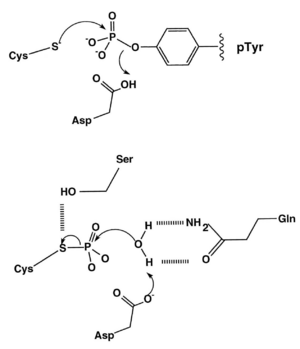Phosphatase
A phosphatase is an enzyme that removes a phosphate group from its substrate by hydrolysing phosphoric acid monoesters into a phosphate ion and a molecule with a free hydroxyl group (see dephosphorylation). This action is directly opposite to that of phosphorylases and kinases, which attach phosphate groups to their substrates by using energetic molecules like ATP. A common phosphatase in many organisms is alkaline phosphatase.
Phosphatases can be categorised into two main categories: Cysteine-dependent Phosphatases (CDPs) and metallo-phosphatases (which are dependent on metal ions in their active sites for activity).
Contents |
Mechanism
CDPs catalyse the hydrolysis of a phosphoester bond via a phospho-cysteine intermediate [1].

The free cysteine nucleophile forms a bond with the phosphorus atom of the phosphate moiety, and the P-O bond linking the phosphate group to the tyrosine is protonated, either by a suitably positioned acidic amino acid residue (Asp in the diagram below) or a water molecule. The phospho-cysteine intermediate is then hydrolysed by another water molecule, thus regenerating the active site for another dephosphorylation reaction.
Metallo-phosphatases (eg PP2C) co-ordinate 2 catalytically essential metal ions within their active site. There is currently some confusion of the identity of these metal ions, as successive attempts to identify them yield different answers. There is currently evidence that these metals could be Magnesium, Manganese, Iron, Zinc, or any combination thereof. It is thought that a hydroxyl ion bridging the two metal ions takes part in nucleophilic attack on the phosphorus
Sub-types
Phosphatases can be subdivided based upon their substrate specificity.
| Class | Example | Substrate | Reference |
|---|---|---|---|
| Tyrosine-specific phosphatases | PTP1B | Phospho-Tyrosine | [2] |
| Serine/Threonine specific phosphatases | PP2C | Phospho-Serine/Threonine | [3] |
| Dual Specificity Phosphatases | VHR | Phospho-Tyrosine/Serine/Threonine | [4] |
| Histidine Phosphatase | PHP | Phospho-Histidine | [5] |
| Lipid Phosphatase | PTEN | Phosphatidyl-Inositol-3,4,5-Triphosphate | [6] |
Physiological relevance
Phosphatases act in opposition to kinases/phosphorylases, which add phosphate groups to proteins. The addition of a phosphate group may activate or de-activate an enzyme (e.g., Kinase signalling pathways[7] ) or enable a protein-protein interaction to occur (e.g., SH3 domains [8]); therefore phosphatases are integral to many signal transduction pathways. It should be noted that phosphate addition and removal do not necessarily correspond to enzyme activation or inhibition, and that several enzymes have separate phosphorylation sites for activating or inhibiting functional regulation. CDK, for example, can be either activated or deactivated depending on the specific amino acid residue being phosphorylated. Phosphates are important in signal transduction because they regulate the proteins to which they are attached. To reverse the regulatory effect, the phosphate is removed. This occurs on its own by hydrolysis, or is mediated by protein phosphatases.
Protein phosphatases
Serine/threonine-specific protein phosphatases
Serine and threonine phosphates are stable under physiological conditions, so a phosphatase has to remove the phosphate to reverse the regulation. There are several known groups with numerous members in each:
- PP1 (α, β, γ1, γ2)
- PP2 (formerly 2A)
- PP3 (formerly 2b, also known as calcineurin)
- PP2C
- PP4
- PP5
- PP6
All but PP2C have sequence homology in the catalytic domain, but differ in substrate specifity.
Ser/Thr-specific protein phosphatases are regulated by their location within the cell and by specific inhibitor proteins.
See also
- Acid salt
- Endonuclease/Exonuclease/phosphatase family
References
- ↑ Barford, D. Molecular mechanisms of the protein serine/threonine phosphatases, (1996) Trends Bioch Sci,21, 11, pp407
- ↑ Zhong-Yin Zhang, PROTEIN TYROSINE PHOSPHATASES: Structure and Function, Substrate Specificity, and Inhibitor Development (2002), Annual Review of Pharmacology and Toxicology,42, pp209
- ↑ Mumby, MC & Walter, G. Protein Serine/Threonine Phosphatases: Structure, Regulation, and Functions in Cell Growth (1993) Physiological Reviews,73,pp673
- ↑ Camps, S et al, Dual specificity phosphatases: a gene family for control of MAP kinase function. (2000) FASEB J,1,pp16
- ↑ Baumner, H et al, Expression of Protein Histidine Phosphatase in Escherichia coli, Purification, and Determination of Enzyme Activity. (2006), Methods Mol Biol, 365, pp247
- ↑ Maehama, T. et al, The tumour suppressor PTEN: involvement of a tumour suppressor candidate protein in PTEN turnover (2004) Biochem. Soc. Trans. 32, pp343
- ↑ Seger & Krebs,The MAPK Signalling cascade, FASEB J,9,pp726
- ↑ Ladbury, JE, Measurement of the formation of complexes in tyrosine kinase-mediated signal transduction,(2007), Acta Cryst D,62,pp26
External links
|
||||||||||||||||||||